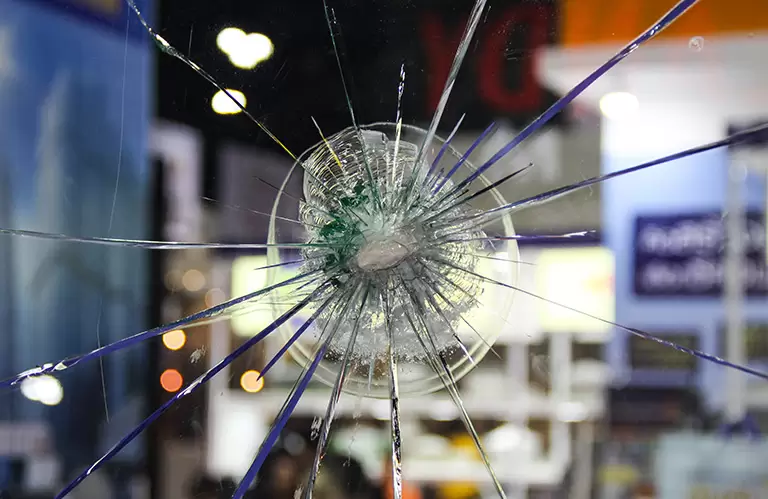Bullet Resistant Glass
Bullet-resistant glass is a strong but optically transparent material that is cannot be penetrated when struck. However, they are not completely impenetrable.
Applications
- Glass is brittle and it does not have a good orderly crystalline structure. If it did, it would be like metal steel, where it dents and deforms instead of shattering.
- This allows the glass to absorb the bullet’s energy by transferring the kinetic energy of the bullet into shattering the glass.
- The softer plastic layer reinforces the glass by holding it in place and allowing the glass to flex back as it absorbs the impact.
- The polycarbonate and laminate also spread the force of the bullet laterally across the entire glass surface.
- Layering these in multiple sheets allows the window to use properties of both materials more effectively; such as the glass on the backside shattering while the undamaged glass holds together the window. This also allows the glass to stop more that one bullet.
- Since polycarbonate is very strong and does not shatter like glass it is an excellent candidate for bullet-proofing.
Bullet Resistance Classification According To European Norms EN 1063
| RN – Round Nose | SC – Soft Core (lead) | AP – Armour Piercing | FJ – Full Metal Jacket | CB-Cone Bullet | LB – Lead Bullet |
| SCP – Soft Core (lead) & Steel Penetrator | API – Armour Piercing Incendiary | FN – Flat Nose | PB – Pointed Bullet | HC – Hard core, steel hardness > 63 HRC |
| Class | Weapon | Caliber | Type | Weight (g) | Range (m) | Velocity (m/s) | Impact Energy | Shots | |
|---|---|---|---|---|---|---|---|---|---|
 |
BR1 | Handgun/Rifle | 0.22 LR | LB/RN() | 2.6 ± 0.1 | 10.00 ± 0.5 | 360 ± 10 | 170 J | 3 |
 |
BR2 | Handgun | 9×19mm Parabellum | FJ/RN/SC | 8.0 ± 0.1 | 5.00 ± 0.5 | 400 ± 10 | 640 J | 3 |
 |
BR3 | Handgun | 0.357 Magnum | FJ/CB/SC | 10.2 ± 0.1 | 5.00 ± 0.5 | 430 ± 10 | 940 J | 3 |
 |
BR5 | Rifle | 5.56×45mm NATO | FJ/PB/SCP | 4.0 ± 0.1 | 10.00 ± 0.5 | 950 ± 10 | 1800 J | 3 |
 |
BR6 | Rifle | 7.62×51mm NATO | FJ/PB/SC | 9.5 ± 0.1 | 10.00 ± 0.5 | 830 ± 10 | 3270 J | 3 |
 |
BR7 | Rifle | 7.62×51mm NATO | FJ/PB/HC | 9.8 ± 0.1 | 10.00 ± 0.5 | 820 ± 10 | 3290 J | 3 |


